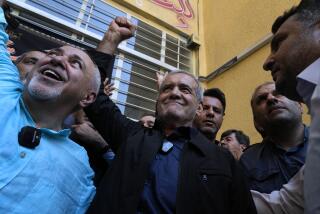Iranians Gather for Persian New Year : Culture: On Sizdeh-Bedar, the faithful eat and celebrate outdoors to keep their traditions alive.
- Share via
IRVINE — Arjang Arjangian thought something was missing when he saw the sign on Culver Drive near Mason Park on Sunday that read, “Persian New Year Celebration,” with an arrow pointing to the next right.
“They should have added, ‘ . . . and Arabian Nights.’ All this culture and this ancient custom in the middle of Irvine, California,” he said. “To me, it’s so surreal.”
Arjangian, an Iranian native who runs his own desk-top publishing company in San Pedro, was not trying to mock the sign or the celebration. Indeed, he was among organizers of the event, which by police estimate drew 30,000 people, mostly Iranian natives or their children, to mark Nou-Rooz, the Persian New Year.
All over Southern California, home to about 500,000 Iranians, the 13th day of Nou-Rooz was celebrated in outdoor events Sunday. Technically, Sunday was the 12th day of the Persian New Year, but, as with many other customs brought to the United States by immigrants, the celebration was altered to accommodate the workweek.
On the 13th day of Nou-Rooz, known as Sizdeh-Bedar, it is considered bad luck to stay indoors, so Iranians bundle up their children and their older relatives, pack a lunch and take to the outdoors.
“It’s a way for us to keep our culture and our traditions alive and to encourage the young people to remember all this,” Behzad Khazale, 30, an event organizer from Santa Monica, said about the Irvine celebration. “It’s also an excuse for us to see our friends on the weekend.”
On one hand, the celebration seemed little more than a big picnic. Unlike other ethnic celebrations, this one had no booths selling food or souvenirs or cassette tapes of traditional music.
But as at other ethnic events, the native language--in this case, Farsi--could be heard everywhere, and the smell of traditional cuisine--barbecued meat for this affair--wafted through the air. And a variety of traditional customs were re-enacted.
At midday, hundreds gathered around a ring decorated in red, white and green, the colors of the Iranian flag, to watch an athletic event called varzesh baustani , or dance of the heroes.
This ancient sport evolved from a postwar celebration to a performance of skill that is part aerobic exercise and part juggling, set to traditional music and song.
As the wind swayed the eucalyptus trees in the background, 16 men and boys--ranging in age from 5 to 65--danced around in a circle, dressed in colorful, embroidered knickers and white sweat shirts, their feet shod in designer sneakers.
They juggled wooden pins that weighed up to 40 pounds as another man chanted the words of an ancient epic and banged on a drum.
Arman Sadeghi, 13, took his turn at juggling smaller pins and throwing them in the air. The crowd applauded him enthusiastically, even on the few occasions when he failed to catch the pin.
“I just do this because I like keeping my Persian customs,” said Sadeghi, an eighth-grader at New Heart Junior High School in Mission Viejo. “I just like the sport.”
Shahrzad Sepanloa, 18, a drama major at Mount San Antonio College in Hacienda Heights, stood at the ring to watch the sport, dressed in slim black jeans, a white T-shirt and high-top leather boots.
“We have to respect ourselves and our own traditions in order for others to respect us,” she said.
Most of the day, small knots of families and friends gathered to munch on shish kebabs marinated in a yogurt-based dressing, falafel bread and ash reshteh, a traditional New Year soup of noodles, mint, garlic and vinegar.
Mothers pushed babies in carriages. An old man strummed a Tar , a traditional Iranian guitar with a swollen body and six strings stretched across lambskin, while a boy played with a hockey stick. Older men quietly competed across backgammon boards.
Young people chatted with each other, some of them finding new romances.
Banafsheh Akhlaghi, 22, of Mission Viejo, said the celebration was important to her because she came to America at a young age and wants to learn more about ancient Persian traditions.
“I’ve been here 17 years, and to see the traditions continuing in this country is very, very important,” she said. “However we, the first generation of Iranians to grow up here, see our customs are going to influence the generations to come who are raised here.”
It has been more than 10 years since the largest group of Iranians who have settled in the United States fled their country, when Ayatollah Ruhollah Khomeini came to power after the Shah of Iran was overthrown in 1979.
Some of those gathered at Sunday’s celebration said they hoped that Iran’s role in the Persian Gulf War will help to heal the bad relations between their adopted and native countries.
“We are hopeful about that, because then it would be easier for all of us to come and go to visit the families we left behind,” said Arjangian. “Most of us came here as exiles, although it would be difficult for many of us, especially the younger people who grew up here, to go back.”
More to Read
Sign up for Essential California
The most important California stories and recommendations in your inbox every morning.
You may occasionally receive promotional content from the Los Angeles Times.










